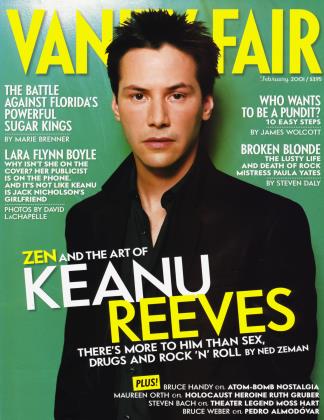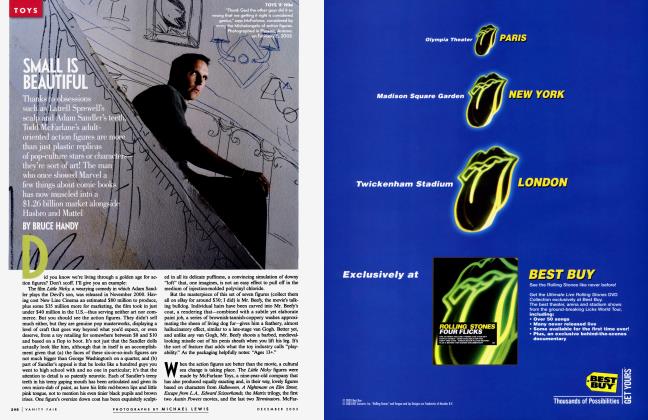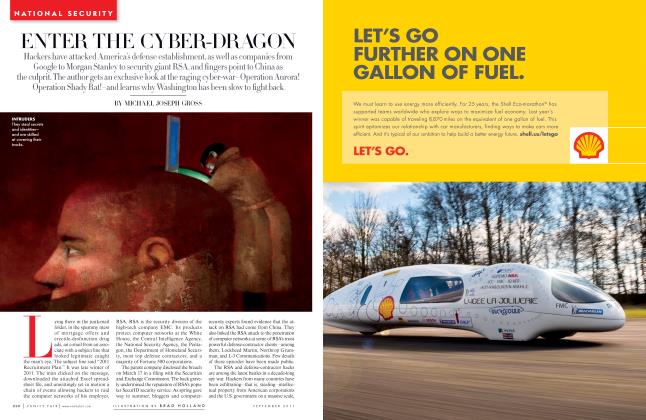Sign In to Your Account
Subscribers have complete access to the archive.
Sign In Not a Subscriber?Join NowBLAST FROM THE PAST
SOCIETY
The George Clooney remake of Fail-Safe was followed by Showtime’s update of On the Beach, the Broadway hit Copenhagen, and now the feature Thirteen Days, starring Kevin Costner, about the Cuban missile crisis. Are we indulging in a perverse nostalgia for Cold War cliff-hangers, mushroom clouds, and mutually assured destruction?
BRUCE HANDY
You don’t see a lot of mushroom clouds these days—which is not a complaint, just an observation. But that unfamiliarity suggests why the producers of Thirteen Days, the recently released film about the Cuban missile crisis, chose to begin their movie with stock footage of rocket launches and A-bomb blasts. The point, presumably, is to remind contemporary audiences—who may not even remember the fall of the Berlin Wall, let alone Doomsday scenarios—of just what was at stake in October 1962 when the Kennedy administration caught the Soviet Union sneaking nuclear warheads and medium-range missiles into Cuba and both sides subsequently came as close as they ever did to setting off World War III. And so, as the movie opens, bomb after bomb detonates, iridescent flashes followed by towering clouds, their long stalks topped with smokeblossoms of an angry, oily intensity that look more like broccoli than mushrooms (but “mushroom cloud” does have a nice, onomatopoeic ring). The film’s music cues us to feel dutifully uneasy, yet you can’t help but enjoy the montage on a purely visual level: the explosions are dazzling, the best light show the Pentagon can buy. If you didn’t know each one had the explosive force of God knows how many mega-tons of TNT, and fogged the atmosphere with God knows how much radioactive ash, you might even think they were wondrous in a scary, force-of-nature way, like a tornado or Liza Minnelli. You can certainly see why, back in the allegedly more innocent 1950s, the word “atomic” became a kind of commercial synonym for pep, why Count Basie used a photo of a mushroom cloud on the cover of his 1957 album E=MC2. Talk about swing.
The release of Thirteen Days nearly a decade after the dismantling of the Soviet Union poses an implicit question: even though the nuclear threat has hardly disappeared (together, the U.S. and Russia presently have about 13,000 nuclear warheads; that’s down from more than 20,000 at the Cold War’s height, but still... ), are we now prepared to feel a kind of perverse nostalgia for the Bomb, as it used to be called back in the days of the Pill and the Method? Do we harbor a wistfulness for such now quaintly evocative terms as “firststrike capability” and “mutually assured destruction,” for the bygone iconography of silos and bomber wings, for MIRVS and ICBMs, NORAD and SAC, for hot lines and war rooms and U.N. debates that actually mattered—even for the prospect, attendant in all this, of our own extinction? The makers of Thirteen Days are, in fact, counting on a certain historic resonance, if not quite unalloyed nostalgia, to sell their account of how the world almost ended. “Potentially this is a family film,” said Peter Almond, one of the producers of Thirteen Days, discussing with me what the film’s market research had turned up in the weeks preceding its release. “People in their 40s want to share this with their children, this experience of what the most terrifying aspect of the Cold War, the nuclear threat, was like. They want to pass on their experience the way Saving Private Ryan brought World War II back to the nation’s consciousness.” In other words, baby-boomers may not have had D-day, but duck-and-cover drills weren’t nothing.
As it happens, we are in the midst of a small though distinct nuclear boomlet in the popular arts. Only last spring CBS aired a remake, produced by and starring George Clooney, of the 1964 film Fail-Safe, a cautionary tale in which an inexplicable technological boner sends American warheads whistling first toward Moscow and then, by way of an apology, Manhattan. Hard on that project’s heels was Showtime’s remake of On the Beach, the 1959 film (based on Nevil Shute’s 1957 novel) set in a post-World War III Australia that has become civilization’s last outpost of alcoholism and bad dialogue. On Broadway, meanwhile, the current Tony Award winner for best play, Michael Frayn’s Copenhagen, is a cerebral drama about the science behind the atomic bomb and the morality of having puzzled it out. The real proof of a cultural trend, however, is whether anyone is exploiting it for commerce, and my own spasmodic television viewing has turned up a couple of recent nuclear-themed ads: a spot for IBM in which a group of Japanese businessmen meet in a conference room that explicitly recalls Dr. Strangelove’s famous war-room set, and a spot for Sun Microsystems in which various offices are blown away by nuclearblast-like shock waves. “Your competition will never know what hit them,” explains an announcer, paraphrasing the physicist Edward Teller, father of the H-bomb.
The two TV remakes were curious works of pop-cultural archaeology. The impetus for exhuming Fail-Safe, Clooney told numerous interviewers, was his own morbid love of the original film, which was directed by Sidney Lumet and starred Henry Fonda as an earnest president and, improbably, Walter Matthau in the part of an amoral nuclear-arms expert. Clooney’s new version, still set in the early 60s, was a unique hybrid: a cautionary period piece. The script was adapted from the Lumet movie by the original screenwriter, Walter Bernstein, and hewed closely to the first film; Clooney’s production was also shot in black and white, as had been the film. “We are trying to make this old,” Clooney told the Los Angeles Times.
Do we harbor a wistfulness for such now quaintly evocative terms as "first-strike capability"?
“We want to do the exact opposite of MTV. We want stillness and silence.” Further enhancing the retro-ness of it all was the fact that the two-hour production was broadcast live. In the ratings, Fail-Safe placed a respectable second to Regis Philbin’s then indomitable Who Wants to Be a Millionaire, drawing 10 million viewers who, whether or not they were entertained or edified, could claim to have seen a unique fusion of the quaint and the horrific, an old-fashioned countdown to nuclear holocaust as embalmed and artificially cute, in its dark way, as one of those fake Eisenhower-era diners that are now replacing all the real ones in Los Angeles.
The makers of the new On the Beach at least made a slight effort to rethink their material: the 1959 film, like the novel, was set in the near future of 1964; the new film turned the calendar to 2006, denuding the project of any camp value—and so it was widely panned and left little trace in the public consciousness. The original was a far different affair. Produced and directed by Stanley Kramer—who made a career out of message films such as The Defiant Ones and Judgment at Nuremberg—On the Beach was conceived as a self-important film; indeed, self-importance was its guiding aesthetic—that and a stiff-upper-lip romantic fatalism borrowed from Brief Encounter. Kramer even arranged to have the film premiere simultaneously in 18 cities spanning the inhabited continents, from Moscow and New York to Tokyo and Paris. Linus Pauling, the chemist and Nobel Peace Prize winner, was quoted as saying, “It may be that some years from now we can look back and say that On the Beach is the movie that saved the world.” To which Pauline Kael replied, in a 1965 essay on Kramer, “Six years have passed: does anyone remember On the Beach as anything more than a lousy movie?” Though windy and predictably lugubrious, it nevertheless worked as tragedy in the bluntest sort of way, since (1) everyone dies, even a baby, and (2) the roster of the doomed includes A-listers such as Ava Gardner, Fred Astaire, and Gregory Peck. The Showtime version’s cast—Rachel Ward, Bryan Brown, and Armand Assante—was less upsettingly disposed of.
Thirteen Days obviously differs from these other projects in that it is not a cinematic op-ed piece but rather a drama based on a historic event, and thus one that has a happy ending—by definition, since someone is around to reenact it. The riveting and unusually intelligent two-and-a-half-hour film, directed by Roger Donaldson (No Way Out and Cocktail), takes us into the Kennedy administration’s deliberations during the missile crisis. It stars Kevin Costner as the White House aide and Kennedy loyalist Kenny O’Donnell; by the time Khrushchev finally blinks, one has even gotten used to Costner’s unusual Boston drawl, which seems taken in equal parts from Kennedy’s reallife Irish mafia and from Costner’s previous performance in Bull Durham. Though historians may quibble with some of the new film’s particulars, they should largely be pleased, seeing as how Thirteen Days is the only movie in the last 40 years to presume that its audience has even a vague idea who Dean Acheson was.* Still, this is an $80 million Hollywood thriller, not a Council on Foreign Relations seminar. The stakes alone give it a kind of dangerous, even sexy urgency—a hint of the early James Bond glamour that the Kennedys exploited in real life just as the filmmakers do here, what with top-secret satellite photos, stiff drinks, and sack-suited New Frontiersmen being whisked to and fro in sleek, black government limousines with impressive tail fins— which, as it happens, were originally designed to mimic the erotic appeal of a guided missile.
* Harry Truman’s secretary of state, if you’re wondering. Are you? It’s O.K. if you’re not.
That observation—that military hardware can have a certain fetishistic allure—was famously one of the central jokes of Dr. Strangelove (subtitled How I Learned to Stop Worrying and Love the Bomb). Stanley Kubrick’s 1964 black comedy ends with the bomber pilot played by Slim Pickens riding an Hbomb bucking-bronco style as it plummets toward ground zero—a warhead literally between his legs. Not that death and sex don’t have a long and tangled history predating Los Alamos, but the prospect of extinction certainly focuses the libido, if one is inclined that way. The original Fail-Safe dallies in this vale in what must rank as one of the ickiest attempted seductions ever put on-screen and is thus worth detailing here (it was cut, alas, from the Clooney version):
A Georgetown party is breaking up at dawn. Walter Matthau’s arms expert, who has spent the evening blithely speculating about how many tens of millions of people might die in a nuclear exchange, finds a hot number unexpectedly reclining in the passenger seat of his convertible. As he drives her home, she says to him, her voice all breathy, Dolce Vita languor, “We all know we’re going to die, but you make a game out of it. A marvelous game that includes the whole world. And you make it seem possible.”
Matthau (annoyed): “It is possible. Even probable.”
She: “You make death an entertainment. Something that can be played in a living room.”
Matthau: “As good a place as any.”
She: “No. There’s an even better place. Pull in here.”
But he doesn’t. Instead he stops the car, slaps her (“I’m not your kind,” he explains), and we cut, perhaps with relief, to the boys-only world of the Strategic Air Command. Not that everyone would respond to this provocation in the same way; it would be interesting to know whether President Kennedy’s frequency of conquest picked up or tapered off during the missile crisis, an aspect of history that Thirteen Days—which was partially funded by one of Kenny O’Donnell’s sons—declines to touch upon.
The prospect of extinction certainly focuses the libido, if one is at all inclined that way.
We have now been living with the possibility of all-out nuclear war for close to half a century, but the fact that this has taken Armageddon out of the hands of woolly first-century prophets and given it to people who are ruthless enough to lead nations only fitfully penetrates the public’s consciousness. Fail-Safe, Dr Strangelove, and On the Beach were part of the first great cycle of nuclear-war movies, all released at the height of the Cold War, after both sides had first acquired the means to vaporize whole peoples. A second cycle, including works such as Testament (1983) and the TV movies World War III (1982) and The Day After (1983), cropped up during the early years of the Reagan administration, when NATO was installing new medium-range missiles in Europe, the nuclear-freeze movement was at its height, and the president was indulging in loose apocalyptic talk about “the evil empire.” In that environment, The Day After—a disastermovie-style depiction of a nuclear strike on Kansas, with Jason Robards, JoBeth Williams, and Steve Guttenberg starring as just plain folks—was thought to be so disturbing and graphic that the administration dispatched a visibly annoyed Secretary of State George Shultz to a post-broadcast town-hall meeting, where he assured Ted Koppel that the president wasn’t secretly keen on flattening Vladivostok. Watching the film now, though, it’s hard to see what the fuss was about: genuinely frightening sequences, such as the confused, disbelieving moments before the bombs go off, are more than offset by risible foreshadowing, such as when a young bride-to-be asks her horny fiance, “Can’t you wait just a few more days?” (Better not, dude!) The film’s later stages also afford the curious pleasure of watching Guttenberg’s hair fall out.
Why we are now seeing another renaissance of nuclear films is less immediately obvious, if there is a reason aside from the usual cultural wheelturning that brings back everything—70s wrap dresses, Charlies Angels, a Bush administration, to cite three recent examples. Jonathan Schell, the writer whose 1982 book, The Fate of the Earth, introduced the public to the concept of nuclear winter and became the Silent Spring of the freeze movement, sees a growing public concern with post-Cold War nuclear issues such as proliferation among countries like India and Pakistan, the threat of nuclear terrorism, the renewed debate in the U.S. over missile defenses, and the fact that no one really knows how much plutonium is lying behind file cabinets in the former Soviet Union. “There are things stirring,” Schell says of goings-on among anti-nuclear activists. “They just haven’t quite risen above the level of the radar yet.” He notes that 50 town meetings in Vermont have recently called for the abolition of nuclear weapons. “That’s the way the freeze started,” he adds, sounding not particularly hopeful.
The end of the Cold War and the comforts of the 90s economic boom have supposedly provoked a perverse longing in the body politic (or at least among journalists and pundits) for the excitement of the old days, when big, scary Soviets vowed, “We will bury you!,” as if they were baiting the rubes at a World Wrestling Federation smackdown. (Of course, our own conflicted thoughts on this subject are nothing compared to the Russians’, for whom the Cold War represents a period when they could boast of actually having an economy.) Perhaps the resurgent wave of nuclear culture simply reflects the fact that, wishfully or not, many people have banished the specter of atomic warfare to the distant past—and that people tend to feel at least a small measure of fondness for the past, no matter how terrifying it actually was. For example, this scene from The Day After: “It’s like 1962 all over again,” says the Jason Robards character’s wife, played by Georgann Johnson, as the couple lie in bed watching an ominous newscast the night before the missiles fly. Robards and Johnson then begin reminiscing about how they conceived their daughter during the Cuban missile crisis, back when they were happy, barefoot-in-the-park newlyweds living in New York City. It’s a cozy, nostalgic moment, though unfortunately short-lived. □
 View Full Issue
View Full Issue


















Subscribers have complete access to the archive.
Sign In Not a Subscriber?Join Now